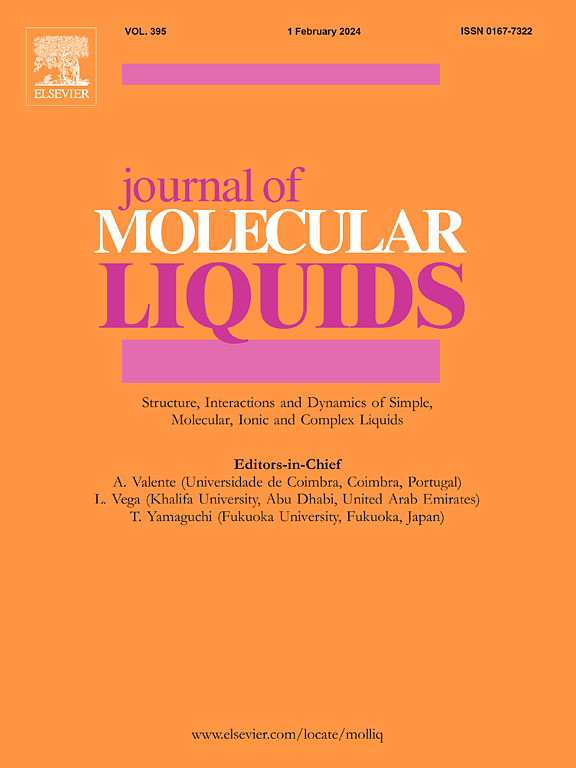Dispersion of multiferroic nanoparticles in a bent-core nematic liquid crystal: Experimental and theoretical study
IF 5.3
2区 化学
Q2 CHEMISTRY, PHYSICAL
引用次数: 0
Abstract
A novel nanocomposite system has been prepared by dispersing multiferroic bismuth ferrite nanoparticles (BiFeO3) in a bent-core nematic liquid crystal (8-F-OH) that exhibits cybotactic clusters. Transition temperature, optical textures, order parameter (Sm), and dielectric spectroscopy experiments are performed in the doped system, and the results are compared with the pure one. The main experimental outcome is that the doped system has increased orientational order parameters, even though the cybotactic cluster size is reduced due to the incorporation of multiferroic BiFeO3 nanoparticles. The transition temperature, as observed under a polarizing optical microscope, clearly indicates a reduction of in the doped system compared to the pure one, and we conjecture this is due to the disordering of the cybotactic cluster in the doped system. Based on the experimental findings, a Landau-de Gennes-type free energy model is developed. The model qualitatively explains the increased mean order parameter and the disordering of cybotactic clusters with increasing polarization value of nanoparticles. This is corroborated by experimental findings.
多铁纳米粒子在弯曲核向列液晶中的分散:实验和理论研究
将多铁铋铁氧体纳米粒子(BiFeO3)分散在具有细胞活性团簇的弯曲核向列液晶(8-F-OH)中制备了一种新型纳米复合体系。在掺杂体系中进行了转变温度、光学织构、序参量(Sm)和介电光谱实验,并与纯掺杂体系进行了比较。主要的实验结果是,尽管由于掺入了多铁BiFeO3纳米粒子,胞浆团簇尺寸减小了,但掺杂体系的取向有序参数增加了。在偏光显微镜下观察到的转变温度清楚地表明,与纯体系相比,掺杂体系的转变温度减少了1−2°C,我们推测这是由于掺杂体系中胞浆团簇的无序所致。基于实验结果,建立了Landau-de gennes型自由能模型。该模型定性地解释了随着纳米粒子极化值的增加,平均有序参数的增加和细胞活性团簇的无序性。实验结果证实了这一点。
本文章由计算机程序翻译,如有差异,请以英文原文为准。
求助全文
约1分钟内获得全文
求助全文
来源期刊

Journal of Molecular Liquids
化学-物理:原子、分子和化学物理
CiteScore
10.30
自引率
16.70%
发文量
2597
审稿时长
78 days
期刊介绍:
The journal includes papers in the following areas:
– Simple organic liquids and mixtures
– Ionic liquids
– Surfactant solutions (including micelles and vesicles) and liquid interfaces
– Colloidal solutions and nanoparticles
– Thermotropic and lyotropic liquid crystals
– Ferrofluids
– Water, aqueous solutions and other hydrogen-bonded liquids
– Lubricants, polymer solutions and melts
– Molten metals and salts
– Phase transitions and critical phenomena in liquids and confined fluids
– Self assembly in complex liquids.– Biomolecules in solution
The emphasis is on the molecular (or microscopic) understanding of particular liquids or liquid systems, especially concerning structure, dynamics and intermolecular forces. The experimental techniques used may include:
– Conventional spectroscopy (mid-IR and far-IR, Raman, NMR, etc.)
– Non-linear optics and time resolved spectroscopy (psec, fsec, asec, ISRS, etc.)
– Light scattering (Rayleigh, Brillouin, PCS, etc.)
– Dielectric relaxation
– X-ray and neutron scattering and diffraction.
Experimental studies, computer simulations (MD or MC) and analytical theory will be considered for publication; papers just reporting experimental results that do not contribute to the understanding of the fundamentals of molecular and ionic liquids will not be accepted. Only papers of a non-routine nature and advancing the field will be considered for publication.
 求助内容:
求助内容: 应助结果提醒方式:
应助结果提醒方式:


